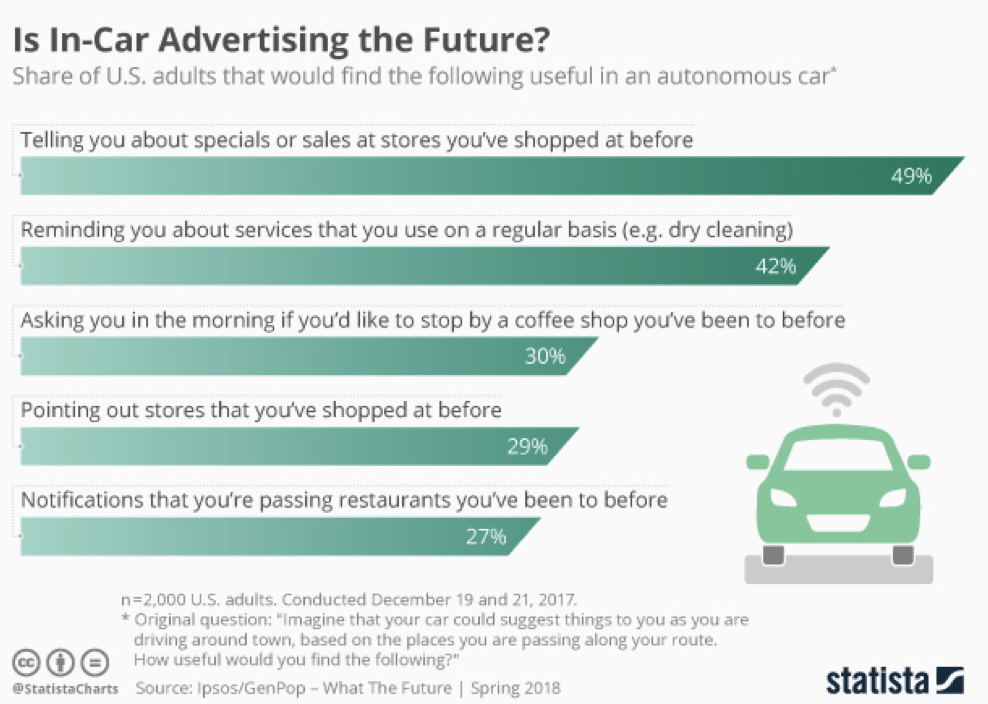One of the more inevitable technologies that will impact our lives in the next 5-10 years will be autonomous vehicles. And one of the ultimate virtues of these cars will be that you as a passenger will not have to actually drive the vehicle but could instead, lean back and read, watch a video, etc.
But as this chart below points out, any person in a self-driving car will probably become a major target for location-based advertising.
The key question this survey asked was “Imagine that your car could suggest things to you as you are driving around town, based on the places you are passing along your route. How useful would you find the following?”
Those who took the survey, some 2000 people, knew the car would be a self-driving one and their responses to this question is in this chart.
Given the question’s parameters, I should not have been surprised at these answers. We have some of this location-based advertising in our in-car GPS systems now that point out gas stations, restaurants, and even some services today.
But until I had a call with a top advertising executive in Washington, DC last week, I did not realize that the advertising world is salivating over this idea and are gearing up to innovate and potentially bombard us with ads as we take our seats in vehicles that we no longer have to drive.
When I first looked at this chart, my initial response is no way. I do not want to be targeted as I drive around. But my bias was based on the way I drive today. Since I am at the wheel and don’t want to have any distractions while I drive, anyone pushing an ad to me is an onerous idea. But if I am not at the wheel and then this type of advertising makes sense.
However, the idea of a car being a new “vehicle” for advertisers is important. Conservative estimates suggest by 2025 we could have at least 5 million self-driving cars on the road and by 2030 we could see well over 20+ million. Many of these self-driving vehicles in the first stages will be in fleets and will work more like driverless on-call taxis. If you have been in a cab in NYC or other major cities you know that taxies now have video-based adds in these cabs and some cases they are tied to dedicated video programs that tell about what you can do in that city or give suggestions on places to eat, stay or tourist attractions to visit.
The advertising distribution companies are already vying to become the ones to supply special video monitors or even interactive terminals in these fleet cars so people can see ads and, in some cases, even buy tickets to tourist attractions that are printed out for them in the car as they drive to that attraction. For advertisers, the ability to use fleet vehicles for ads is a relatively easy proposition.
But the bigger question they are working on is ” How do we bring location-based advertising to people who buy their self-driving cars in the future?” In Fleet cars, they can do deals to add these video screens and terminals. But for private vehicles, this is a more complicated issue. Do they cut deals with the car makers? Do they provide video screens or terminals free to private owners of self-driving vehicles? Do they hope that users will be looking at their smartphones or tablets and use them to share ads while they are chauffeured here or there on any given trip?
Advertisers see gold when it comes to providing ads for the automated driving crowd in the future but have some difficult roads to navigate before they ever reach their goals. The good news for them is that there are 5-10 years to get it right, but if you know the history of advertising, get it right they will even if it takes time.


Greetings! Very helpful advice in this particular article! It is the little changes which will make the most important changes. Thanks a lot for sharing!